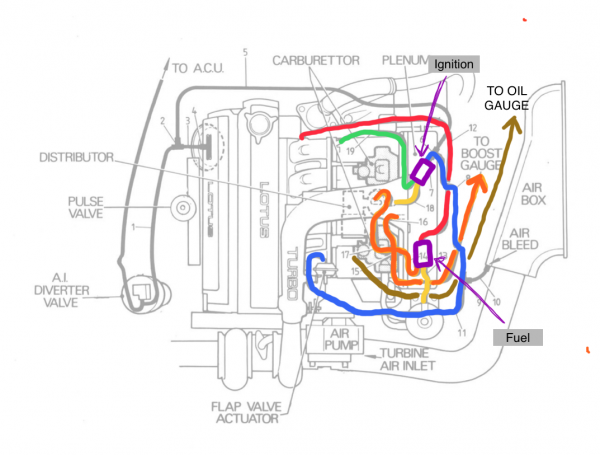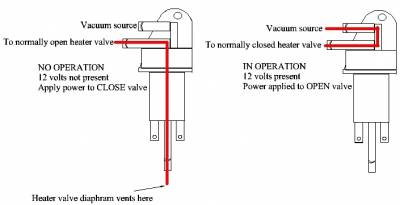Vacuum Routing
Vacuum routing is slightly different between certain model years (and US/UK models). Most of this is US-centric information.
The US cars had air pumps equipped for emissions compliance. Most owners removed this system due to the fact that it would frequently break. The diverter valve and the associated plumbing is usually removed. Additionally, although the vacuum diagram seems to indicate that there is a line coming off the vacuum pump, this doesn't appear to be the case for many cars.
As explained below, the two purple boxes are the vacuum solenoids for fuel pressure and ignition. When the solenoids are not energized, the yellow and green lines are connected (ignition), and the yellow and orange lines are connected (fuel). When the solenoids are energized the blue and green lines are connected (ignition) and the red and orange lines are connected (fuel).
Vacuum Solenoids
Fuel Pressure & Ignition
There are a pair of solenoids mounted under the intake plenum for fuel pressure and ignition. Lotus refers to these as part #A910E6634F.
I took some time to test and investigate these solenoids (they are identical parts, but serve two different purposes).
These solenoids are a German Pierburg part (#7.12942.00) they are not necessarily an easy part to find (right now, sourcing one is more than $50 USD each).
I tested the solenoid to see the internal routing when energized and when not. The solenoid switches between connecting the top outlet to the bottom-side outlet when energized, or connecting the bottom center outlet to the bottom-side outlet when NOT energized (polarity doesn't matter).
The least expensive replacement unit is an A/C Solenoid Valve part 1470004 or SW9000. This operates in a similar fashion to the stock unit as long as you set up the vacuum lines properly. These can be purchased for about 1/2 the cost of the Pierburg unit.




